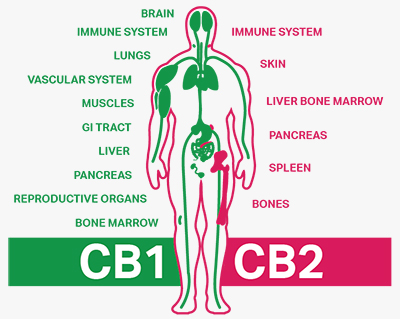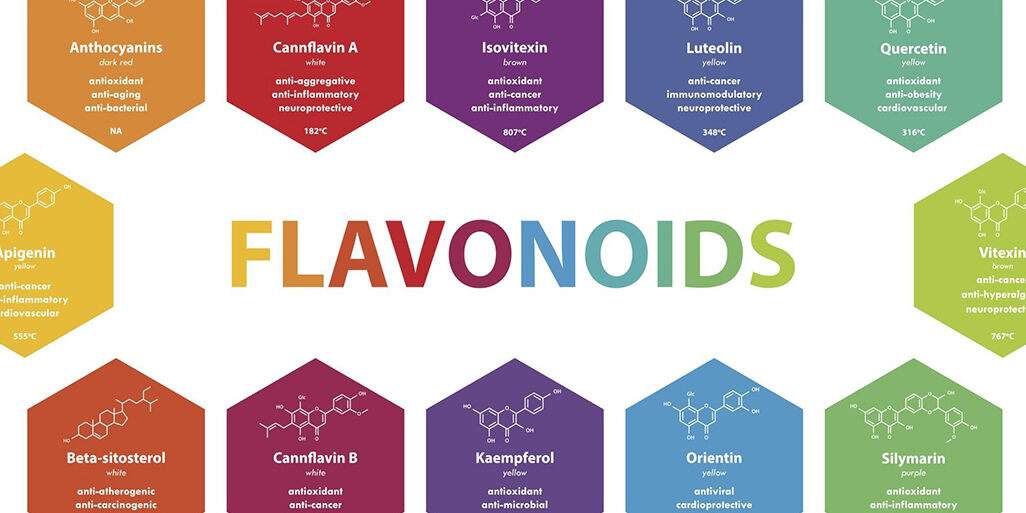What Are Cannabis Flavonoids?
Ever heard of terpenes and phytocannabinoids? They’re the most talked about compounds in cannabis, so much so that you may think they’re the only ones. But marijuana has more bioactive compounds (about 200 more), and flavonoids are one of them.
There are around 20 flavonoid varieties in marijuana, accounting for about 1/10th of the herb’s known compounds. Although flavonoids occur naturally in varieties of fruits, flowers, and vegetables, some of them, called cannaflavins, are specific to cannabis. These flavonoids play significant and unique roles in marijuana’s therapeutic effects.
We’ll discuss everything you need to know about this amazing compound in this article.
What are Marijuana Flavonoids?
 “Flavonoid” originates from the Latin term “flavus,” which means “yellow or blond.” This is about its natural color and the fact that one of its primary functions in plants is to facilitate pollination by providing color pigmentation. As such, many non-green plants have bright colors due to the presence of flavonoids. Flavonoids also help to protect cannabis from pests, diseases, and the harmful effects of sunlight.
“Flavonoid” originates from the Latin term “flavus,” which means “yellow or blond.” This is about its natural color and the fact that one of its primary functions in plants is to facilitate pollination by providing color pigmentation. As such, many non-green plants have bright colors due to the presence of flavonoids. Flavonoids also help to protect cannabis from pests, diseases, and the harmful effects of sunlight.
There are at least 6,000 known flavonoid varieties, and they perform a wide range of functions. Generally, however, they can be described as a class of polyphenolic compounds that indirectly help to metabolize various fungi and plants.
What Roles Do Cannabis Flavonoids Play?
Flavonoids perform numerous functions in cannabis plants as in other species of flowering plants. We’ve discussed the most significant ones below:
Enhancers
By “enhancers,” we mean flavonoids give marijuana character. They help to enhance the plant’s flavors, aromas, and colors that distinguish one cannabis strain from another. That’s right; when it comes to cannabis aromas and flavors, terpenes don’t do all the work. They have to combine their best qualities with those from flavonoids to give your marijuana its odor and taste.
In other words, flavonoids complement the fragrant characteristics of terpenes. They do this by incorporating delicate, yet complex flavor and aroma layers to enhance its overall sensory appeal.
It’s important to note that cannabis strains with deep purple, red, and blue colors have anthoxanthins (also anthocyanins) to thank for their attractive colorations. Guess what contains anthoxanthins? Flavonoids, of course.
Bioactives
More than just influencing the colors, tastes, and aromas of plants, flavonoids play significant roles in the pharmacology of plants. According to preliminary research, marijuana offers multiple medicinal benefits to humans partly because of its cannaflavin contents. For example, quercetin, a flavonoid common in many plants and veggies, has been found to contain anti-fungal and antioxidant properties. It’s the same thing with catechins found in teas, cocoa, etc., that help to improve heart health.
Meanwhile, cannabis contains the pharmacologically active cannaflavin A that may match or even beat aspirin in terms of its anti-inflammatory properties. Research is still being conducted about cannaflavin B and C, as well as other flavonoids like orientin, silymarin, kaempferol, and quercetin, to determine their health benefits.
Synergists
 There’s a popular term that describes how numerous pharmacologically active compounds interact synergistically in marijuana. It is “the entourage effect.” As the term suggests, the effects of these compounds are more pronounced when they work together as an entourage than individually. Some experts believe that flavonoids are one of them.
There’s a popular term that describes how numerous pharmacologically active compounds interact synergistically in marijuana. It is “the entourage effect.” As the term suggests, the effects of these compounds are more pronounced when they work together as an entourage than individually. Some experts believe that flavonoids are one of them.
Every human has an endocannabinoid system that comprises CB1, CB2, and other receptors. This network of receptors is bound by cannabinoids to trigger different reactions, which are again influenced by the combined interaction of cannabinoids and terpenes. Just like cannabidiols regulate how THC affects the blood-brain barrier, flavonoids are believed to have similar synergistic qualities. However, note that no one fully knows the extent to which they enhance cannabinoid properties or regulate their effectiveness.
Flavonoids: A Grossly Understudied Domain
It wasn’t until 1998 that Dr. Raphael Mechoulam and S. Ben-Shabat coined “the entourage effect,” which is now a widespread term in marijuana research. Although Dr. Mechoulam, James MacPartland, Ethan Russo, and a few other scientists have been focusing their resources on studying flavonoids, there are still many mysteries surrounding these compounds. Compared to cannabinoids and terpenes, very little research has been done on flavonoids, and as the study on this compound progresses, we hope to discover more about its health benefits.
Wrap Up
Just like your romantic partners, loving marijuana means learning everything you can about the substance to improve your appreciation of it. Lucky you, we’re dedicated to helping you know more about this unique substance that gives you joy. If you enjoyed learning about flavonoids, stay glued to our page for more enlightening information. We’ve got you covered!

